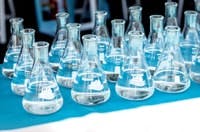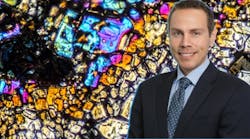In the midst of extreme drought conditions, a new, locally controlled, drought-proof water source for Silicon Valley is now online. On July 18, 2014, the Santa Clara Valley Water District, in partnership with the cities of San Jose and Santa Clara, celebrated the grand opening of the Silicon Valley Advanced Water Purification Center.
Located in northern San Jose, the new purification center, owned and operated by Santa Clara Valley Water District, is already producing up to 8 million gal per day (mgd) of highly purified water from secondary treated wastewater. It is the largest facility of its kind in Northern California.
The product water is currently blended with tertiary treated recycled water to enhance its quality for non-potable industrial and irrigation uses. By demonstrating proven technologies locally, the water district aims to build support for using purified wastewater to expand future drinking water supplies in the region.
The $72-million project began construction in October 2010. The new facility received $8.25 million from the federal American Recovery and Reinvestment Act and $5.25 million from the California Department of Water Resources. The city of San Jose contributed $11 million toward the construction and provided a long-term lease for the land. The water district funded the remainder of the project costs.
The new facility uses advanced technologies to purify water, which has already undergone two levels of wastewater treatment, sourced from the San Jose-Santa Clara Regional Wastewater Facility. At the new purification center, the water goes through three additional processes—microfiltration, reverse osmosis and ultraviolet (UV) light—to produce water with purity that is expected to match drinking water quality.
Instead of being released to San Francisco Bay, the purified water will be blended with existing recycled water and distributed via the regional purple pipe recycled water system, South Bay Water Recycling (SBWR). The water is used for non-potable purposes such as industrial cooling towers, golf courses and car washes throughout the Silicon Valley cities of San Jose, Milpitas and Santa Clara.
Approximately 750 SBWR customers now are enjoying the enhanced recycled water, which has a lower level of total dissolved solids (TDS). Previously, the TDS level in recycled water hovered around 750 mg/L. The new blended recycled water has a TDS level of around 500 mg/L. This helps reduce chemical use and maintenance costs for industrial users, and is easier on some plant species because it reduces salt buildup. Also, higher quality recycled water helps protect the region’s groundwater supplies.
Recycled water has been used successfully in Santa Clara County for decades. The mostly suburban county has four wastewater treatment plants, all of which produce recycled water for non-potable uses. In Sunnyvale, the water district is helping to fund a pipeline that will bring recycled water to Apple’s new futuristic campus in Cupertino. In Santa Clara, SBWR is providing recycled water to the new 49ers Levi’s Stadium.
A Step Toward Potable Reuse
Along one wall of the new facility’s processing building sits a miniature version of a UV vessel, hooked up to a container of hydrogen peroxide. It is a pilot plant, designed to assess the change in water quality when an additional advanced oxidation process (AOP) is added. Because the facility’s product water is currently only used for non-potable purposes, an AOP is not needed. Should the facility ever produce water for indirect or direct potable use, an AOP could be considered as an additional treatment step to eliminate any remaining organic compounds.
Today, recycled water makes up about 5% of the county’s total water demand. By 2025, the water district expects to double that number. The new purification center is one important step to reaching that goal. Not only does it make recycled water more attractive to existing and potential customers, it is demonstrating proven technologies to produce consistently high-quality water that can be used for various potential uses, including expanding drinking water supplies.
Public Perception
Almost 200 local elected officials, community leaders and water agency personnel attended a grand opening event on July 18. To mark the occasion, event staff staged a photo opportunity, inviting elected leaders of the sponsoring agencies to ceremoniously pour purified water into a pair of potted peach trees that flanked the event stage. Instead, in an exuberant display of support for the facility’s ability to produce high-quality water, one after the other, almost all of the leaders spontaneously opted to take a drink themselves.
A recent public opinion poll sponsored by the WateReuse Foundation showed that only 30% of county residents would accept the use of recycled water for drinking water; however, after hearing several positive messages on the subject, opinions changed dramatically. Just in the course of the survey, the level of support for direct reuse of recycled water increased to 57%.
The greatest hurdle to using advanced purified water to supplement drinking water supplies is public perception. Following the lead of other successful potable reuse projects, the water district has launched a comprehensive outreach effort that focuses on facility tours, a website (www.purewater4u.org), and presentations and other community outreach. Such efforts have paid off in places like Orange County, which has a facility that has been so successful, it is being expanded from 70 to 100 mgd.
Meeting Future Water Needs
Recycled water is a major component of the water district’s long-term water supply management plan. This plan also calls for aggressive water conservation savings. Even with aggressive conservation savings, Santa Clara County will need the additional security of a locally controlled, drought-proof water supply. Along with conservation, advanced purified water will help meet the future growth—and associated water supply needs—of the Silicon Valley region.
The new facility could be expanded to produce more than 30 mgd. Water district engineers also have assessed the feasibility of plumbing the facility or others like it to a local groundwater recharge facility. As California continues a process to approve regulations to allow for direct potable reuse, the water district also plans to study the feasibility of connecting an advanced water purification plant directly into its raw water system.
“Growing water demand, uncertain imported water supplies, the present and recurring drought, [as well as] regulatory restrictions and climate change require agencies like ours to both promote the wise use of water and find additional supplies to fill projected future water supply demands,” said Tony Estremera, chair of the Santa Clara Valley Water District board of directors.
Download: Here


